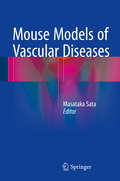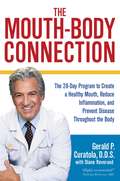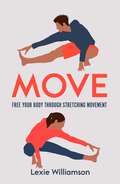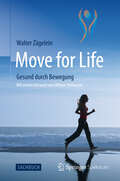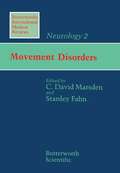- Table View
- List View
Mouse Models of Vascular Diseases
by Masataka SataThis book is a methodological source on mice models of vascular diseases. Covering various areas, each chapter is written by a pioneering researcher who has developed an original vascular disease model. Notoriously difficult to reproduce, each model is described in detail and numerous photographs are provided with links to videos. Genetically modified mice are a very powerful tool for studying the pathogenesis of various diseases, including immunological and oncological disorders, but they had always been thought to be too small to be used in the field of cardiovascular disease. Recently, however, various mice models of vascular diseases have been reported, and these will make a substantial contribution to basic research on cardiovascular and metabolic disorders.
The mouth and throat (Large Print)
by RnibThis image shows a cross section through the head and neck. There is a locator dot shown, which will be at the top left of the page when the image is the correct way up. The head is facing to the left with the body facing forwards. Only parts of the shoulders are shown. The mouth is in the left centre of the page. The lips are slightly parted. To the right are two incisor teeth shown in section. The rounded tongue is to the right of this. Up from the tongue is the thin hard palette which separates the mouth and nasal cavities. The nasal cavity on the left has a small opening which is the nostril that allows air into the nasal cavity. On the right of the nasal cavity is an opening going past the soft palette into the naso-pharynx. This joins the back of the mouth in the start of the throat. Only the top part of the air passageway (larynx) is shown near the epiglottis, the small flap which closes the air passageway when food is being swallowed. Food goes down the oesophagus at the bottom of the page towards the stomach.
The mouth and throat (large print)
by RnibThis image shows a cross section through the head and neck. There is a locator dot shown, which will be at the top left of the page when the image is the correct way up. The head is facing to the left with the body facing forwards. Only parts of the shoulders are shown. The mouth is in the left centre of the page. The lips are slightly parted. To the right are two incisor teeth shown in section. The rounded tongue is to the right of this. Up from the tongue is the thin hard palette which separates the mouth and nasal cavities. The nasal cavity on the left has a small opening which is the nostril that allows air into the nasal cavity. On the right of the nasal cavity is an opening going past the soft palette into the naso-pharynx. This joins the back of the mouth in the start of the throat. Only the top part of the air passageway (larynx) is shown near the epiglottis, the small flap which closes the air passageway when food is being swallowed. Food goes down the oesophagus at the bottom of the page towards the stomach.
The mouth and throat (UEB contracted)
by RnibThis image shows a cross section through the head and neck. There is a locator dot shown, which will be at the top left of the page when the image is the correct way up. The head is facing to the left with the body facing forwards. Only parts of the shoulders are shown. The mouth is in the left centre of the page. The lips are slightly parted. To the right are two incisor teeth shown in section. The rounded tongue is to the right of this. Up from the tongue is the thin hard palette which separates the mouth and nasal cavities. The nasal cavity on the left has a small opening which is the nostril that allows air into the nasal cavity. On the right of the nasal cavity is an opening going past the soft palette into the naso-pharynx. This joins the back of the mouth in the start of the throat. Only the top part of the air passageway (larynx) is shown near the epiglottis, the small flap which closes the air passageway when food is being swallowed. Food goes down the oesophagus at the bottom of the page towards the stomach.
The mouth and throat (UEB contracted)
by RnibThis image shows a cross section through the head and neck. There is a locator dot shown, which will be at the top left of the page when the image is the correct way up. The head is facing to the left with the body facing forwards. Only parts of the shoulders are shown. The mouth is in the left centre of the page. The lips are slightly parted. To the right are two incisor teeth shown in section. The rounded tongue is to the right of this. Up from the tongue is the thin hard palette which separates the mouth and nasal cavities. The nasal cavity on the left has a small opening which is the nostril that allows air into the nasal cavity. On the right of the nasal cavity is an opening going past the soft palette into the naso-pharynx. This joins the back of the mouth in the start of the throat. Only the top part of the air passageway (larynx) is shown near the epiglottis, the small flap which closes the air passageway when food is being swallowed. Food goes down the oesophagus at the bottom of the page towards the stomach.
The mouth and throat (UEB uncontracted)
by RnibThis image shows a cross section through the head and neck. There is a locator dot shown, which will be at the top left of the page when the image is the correct way up. The head is facing to the left with the body facing forwards. Only parts of the shoulders are shown. The mouth is in the left centre of the page. The lips are slightly parted. To the right are two incisor teeth shown in section. The rounded tongue is to the right of this. Up from the tongue is the thin hard palette which separates the mouth and nasal cavities. The nasal cavity on the left has a small opening which is the nostril that allows air into the nasal cavity. On the right of the nasal cavity is an opening going past the soft palette into the naso-pharynx. This joins the back of the mouth in the start of the throat. Only the top part of the air passageway (larynx) is shown near the epiglottis, the small flap which closes the air passageway when food is being swallowed. Food goes down the oesophagus at the bottom of the page towards the stomach.
The mouth and throat (UEB uncontracted)
by RnibThis image shows a cross section through the head and neck. There is a locator dot shown, which will be at the top left of the page when the image is the correct way up. The head is facing to the left with the body facing forwards. Only parts of the shoulders are shown. The mouth is in the left centre of the page. The lips are slightly parted. To the right are two incisor teeth shown in section. The rounded tongue is to the right of this. Up from the tongue is the thin hard palette which separates the mouth and nasal cavities. The nasal cavity on the left has a small opening which is the nostril that allows air into the nasal cavity. On the right of the nasal cavity is an opening going past the soft palette into the naso-pharynx. This joins the back of the mouth in the start of the throat. Only the top part of the air passageway (larynx) is shown near the epiglottis, the small flap which closes the air passageway when food is being swallowed. Food goes down the oesophagus at the bottom of the page towards the stomach.
The Mouth-Body Connection: The 28-Day Program to Create a Healthy Mouth, Reduce Inflammation and Prevent Disease Throughout the Body
by Gerald P. Curatola Diane ReverandAcclaimed oral health expert and wellness pioneer, Dr. Gerry Curatola, explores the bi-directional relationship between the health of your mouth and your body, and provides a groundbreaking program for creating a healthy mouth that will help maintain a healthy body. The mouth acts as mirror and a gateway and reflects what is happening in the rest of your body and the health of your mouth appears to have a profound impact on the rest of your body. Chronic, low-grade oral disease is a major source of inflammation throughout your body, which can sometimes result in serious systemic problems, including cardiovascular disease, type 2 diabetes, obesity, and premature birth. The Mouth-Body Connection educates the reader on the natural ecology of the mouth. The oral microbiome consists of communities of 20 billion microorganisms of more than six hundred types-keeping these communities balanced is the key to well-being. Dr. Curatola's program, thirty years in the making, helps to restore microbiome balance and reduce health-destroying inflammation. The Curatola Care Program fosters a healthy oral microbiome by means of diet, supplements, exercise, and stress reduction. Four weeks of meal plans and fifty delicious recipes will convince you that eating for balance can be a treat. There are supplement schedules for each stage, two high-intensity band workouts that take only 15 minutes twice a week, relaxation techniques, and yoga postures to fight inflammation.In just four weeks, you will reboot your body and begin to take control of your health. Best of all, your brilliant smile will prove that you have never felt better. p.p1 {margin: 0.0px 0.0px 0.0px 0.0px; font: 12.0px Geneva} p.p2 {margin: 0.0px 0.0px 0.0px 0.0px; text-indent: 36.0px; font: 12.0px Geneva} p.p3 {margin: 0.0px 0.0px 0.0px 0.0px; text-indent: 36.0px; font: 12.0px Geneva; min-height: 16.0px} p.p4 {margin: 0.0px 0.0px 0.0px 0.0px; font: 12.0px Geneva; min-height: 16.0px} span.s1 {font: 12.0px Symbol}
The Mouth-Body Connection: The 28-Day Program to Create a Healthy Mouth, Reduce Inflammation and Prevent Disease Throughout the Body
by Gerald P. Curatola Diane ReverandAcclaimed oral health expert and wellness pioneer, Dr. Gerry Curatola, explores the bi-directional relationship between the health of your mouth and your body, and provides a groundbreaking program for creating a healthy mouth that will help maintain a healthy body.The mouth acts as mirror and a gateway and reflects what is happening in the rest of your body and the health of your mouth appears to have a profound impact on the rest of your body. Chronic, low-grade oral disease is a major source of inflammation throughout your body, which can sometimes result in serious systemic problems, including cardiovascular disease, type 2 diabetes, obesity, and premature birth. The Mouth-Body Connection educates the reader on the natural ecology of the mouth. The oral microbiome consists of communities of 20 billion microorganisms of more than six hundred types-keeping these communities balanced is the key to well-being. Dr. Curatola's program, thirty years in the making, helps to restore microbiome balance and reduce health-destroying inflammation. The Curatola Care Program fosters a healthy oral microbiome by means of diet, supplements, exercise, and stress reduction. Four weeks of meal plans and fifty delicious recipes will convince you that eating for balance can be a treat. There are supplement schedules for each stage, two high-intensity band workouts that take only 15 minutes twice a week, relaxation techniques, and yoga postures to fight inflammation.In just four weeks, you will reboot your body and begin to take control of your health. Best of all, your brilliant smile will prove that you have never felt better.
Move: Free your Body Through Stretching Movement
by Lexie WilliamsonAn aspirational and inclusive guide to 'freeing up' the body through dynamic movement, focusing on the 'feel-good' benefits of stretching. Aside from improved flexibility, these include better posture ('standing tall'), reduced back strain and the mental 'brain boost' that results from increased blood flow during movement.Move explores dynamic stretching, or slow flowing movement. This is the most effective way to increase joint range of motion (the 'Move it or Lose it' principle) thereby allowing us to move comfortably and freely, as we were born to do. Uniquely designed to explore just six key move sequences each containing the main planes of motion: flexion (forward bending), extension (back bending), side bending and rotation. They can be used either as five-minute stand-alone routines, or tagged together to form a longer flexibility sequence as you might experience in a flow yoga class. Rather than the common format used in stretching books of detailing the science of stretching, followed by a list of exercises, this book puts the six key moves centre stage and spends most of the book explaining and refining them. The emphasis is on simplicity. There are six key move routines: two lying, one cross-legged, one all fours, one lunge-based and the final one standing. Each routine has just four variations within it. This means the reader does not have to keep switching positions. The book avoids using yoga jargon or sports science language and instead focuses on the 'feel-good' benefits of stretching. In short, the book allows us all you to stretch ourselves happy.
Move: Free your Body Through Stretching Movement
by Lexie WilliamsonAn aspirational and inclusive guide to 'freeing up' the body through dynamic movement, focusing on the 'feel-good' benefits of stretching. Aside from improved flexibility, these include better posture ('standing tall'), reduced back strain and the mental 'brain boost' that results from increased blood flow during movement.Move explores dynamic stretching, or slow flowing movement. This is the most effective way to increase joint range of motion (the 'Move it or Lose it' principle) thereby allowing us to move comfortably and freely, as we were born to do. Uniquely designed to explore just six key move sequences each containing the main planes of motion: flexion (forward bending), extension (back bending), side bending and rotation. They can be used either as five-minute stand-alone routines, or tagged together to form a longer flexibility sequence as you might experience in a flow yoga class. Rather than the common format used in stretching books of detailing the science of stretching, followed by a list of exercises, this book puts the six key moves centre stage and spends most of the book explaining and refining them. The emphasis is on simplicity. There are six key move routines: two lying, one cross-legged, one all fours, one lunge-based and the final one standing. Each routine has just four variations within it. This means the reader does not have to keep switching positions. The book avoids using yoga jargon or sports science language and instead focuses on the 'feel-good' benefits of stretching. In short, the book allows us all you to stretch ourselves happy.
Move for Life: Gesund durch Bewegung
by Walter ZägeleinIn unserer von Technik geprägten Gesellschaft ist in der Regel mangelnde Bewegung ein zentrales Problem. Diese Bewegungsarmut, die oft gepaart ist mit gutem Essen und zu viel Stress, führt häufig zu den typischen Krankheitssymptomen, die von den Ärzten zusammenfassend als metabolisches Syndrom bezeichnet werden. Auf der anderen Seite existiert ein übertriebener Leistungsgedanke, wie beispielsweise beim Leistungssport, der so manchen über das Ziel hinausschießen lässt. Marathon- und Ultralangstreckenläufe, Triathlon und andere Extremsportarten sind dann der Gegenpol zur Bewegungsarmut der anderen. Was und wie viel an Bewegung sind für die Gesundheit nun wirklich förderlich?Diese Frage und noch vieles mehr beantwortet "Move for Life". Themen sind des weiteren auch die Problematik des Älterwerdens und den daraus resultierenden körperlichen Veränderungen. Es werden nicht nur die Aspekte der Bewegung und deren gesundheitsrelevanten Auswirkungen betrachtet, sondern auch die Notwendigkeiten eines Krafttrainings, eines Koordinationstrainings und eines Entspannungstrainings. Dadurch ergibt sich eine umfassende Darstellung dessen, was der moderne Mensch zu seiner Gesunderhaltung benötigt. Der Leser erhält einen tiefen Einblick in diese Thematik und kann daraufhin selbst entscheiden, was für ihn sportlich und gesundheitlich gesehen gut und richtig ist.
Movement Disorder Emergencies: Diagnosis and Treatment (Current Clinical Neurology)
by Steven J. FruchtUpdated and expanded with nine additional chapters, Movement Disorder Emergencies: Diagnosis and Treatment, Second Edition is an indispensable resource for general neurologists, specialists, fellows, and residents eager to improve their approach toward the patient with a movement disorder emergency. In this comprehensive second edition, prominent neurologists from around the world logically and systematically review the major movement disorder emergencies, instructing the reader on how optimally to recognize and manage these problems. The authors cover a broad range of disorders, including acute dystonic reactions, neuroleptic malignant syndrome, startle syndromes, tic emergencies, and others; and they stress the importance of certain obvious diagnoses such as Wilson's disease, dopa-responsive dystonia, and Whipple's disease, in which delayed diagnosis in less emergent situations can lead to slowly evolving and often irreversible neurologic damage with tragic consequences. In addition, nine topics not covered in the first edition are provided, including genetic counseling and testing crises, suicide risk, psychogenic movement disorders, and others. Patient vignettes at the beginning of each chapter focus the reader's attention and highlight the urgency of the problem. Since astute clinical diagnosis of many movement disorders is still largely dependent on visual pattern recognition in the clinic, an accompanying online collection of physician-patient vignettes illustrates virtually all of the movement disorders described in the text. Importantly, the authors also discuss a range of new treatment paradigms that have emerged since publication of the first edition, especially deep brain stimulation. Authoritative and a leading text in the field, Movement Disorder Emergencies: Diagnosis and Treatment, Second Edition is an established, practical reference that continues to achieve excellence in the field of diagnosis and management of movement disorder emergencies.
Movement Disorder Emergencies: Diagnosis and Treatment (Current Clinical Neurology)
by Steven J. FruchtThis book logically and systematically reviews the major movement disorder emergencies. It instructs the reader on how to recognize and manage these problems. This updated new edition of Movement Disorder Emergencies consists of five comprehensive sections. It begins with chapters that relay the various practical approaches one can administer when treating a patient with a movement disorder emergency. Section two then delves into specific hyperacute movement disorder emergencies such as acute parkinsonism, serotonin syndrome, and malignant catatonia. Following this, section three examines various acute movement disorder emergencies, including tic emergencies and Sydenham’s chorea. Sections four and five explore issues that can occur during treatment, such as pitfalls in diagnosis and risks in the clinic. Written by prominent neurologists from around the world, Movement Disorder Emergencies, 3rd edition is a practical reference that achieves excellence in diagnosis and management of movement disorder emergencies.
Movement Disorder Emergencies: Diagnosis and Treatment (Current Clinical Neurology)
by Steven J. Frucht Stanley FahnMovement Disorder Emergencies: Diagnosis and Treatment provides a fresh and unique approach to what is already a high-profile subspecialty area in clinical neurology. The disorders covered in this volume are standard fare in the field but emphasize the urgencies and emergencies that can occur. One of the very attractive features of the field of movement disorders is that diagnosis is often based on unique visible and sometimes audible phenomenological symptoms and signs. Therefore, in this era of highly sophisticated laboratory and radiological diagnostic tools, the diagnosis of many movement disorders is still largely made in the clinic where pattern recognition is key. Crucial to astute clinical diagnosis is broad clinical experience. In short, you have to have seen one to recognize one! Patients with movement disorders nearly always present as outpatients but, as aptly recognized by Drs. Frucht and Fahn, this may include acute manifestations leading to emergency presentations, often in an emergency room setting, where they are very likely to be unrecognized and therefore poorly managed. The authors define an “emergency” movement disorder as one in which failure to promptly diagnose and treat may result in significant morbidity or mortality. However, they also stress the importance of certain “can’t miss” diagnoses such as Wilson’s disease, dopa-responsive dystonia, and Whipple’s disease in which delayed diagnosis in less emergent situations can lead to slowly evolving and often irreversible neurological damage with tragic consequences.
Movement Disorder Genetics
by Susanne A. Schneider José M. Tomás BrásThis book covers recent developments and possible pitfalls in the diagnosis of genetic movement disorders and related conditions. It is divided into three sections: technical and scientific aspects; clinical aspects with guidance towards work-up; and ethical and legal aspects of genetic testing in a clinical and research setting.The first section includes chapters on genetic analysis and counselling with critical discussion of potential problems when interpreting the results. Clinical chapters summarize genetic forms of movement disorders including parkinsonism, tics and dystonia with algorithms for hands-on daily practice. Related conditions such as RLS, ataxias and dementias are also covered. Finally, chapters on ethical and legal aspects of genetic testing are included.Movement Disorder Genetics is aimed at clinicians and scientists working in the field of movement disorders and related conditions.
Movement Disorders: A Video Atlas (Current Clinical Neurology)
by Roongroj Bhidayasiri Daniel TarsyMovement Disorders: A Video Atlas is a practical and concise title offering an introduction to the field of movement disorders, which is expanding rapidly with the involvement of various disciplines and specialties. The unique feature of the book is the accompanying video content, comprising common cases in each category of movement disorders. The video clips come from Dr. Tarsy’s personal video collection at Beth Israel Deaconess Medical Center and Dr. Bhidayasiri's personal collection at Chulalongkorn University and UCLA. The videos can be found at www.springerimages.com/Tarsy. Each case includes expert narration from Dr. Tarsy. Rather than focusing on rare cases, the authors emphasize typical cases, with good history and physical signs. Unique, easy to read, with highly instructive supporting video content, Movement Disorders: A Video Atlas is an indispensable reference for all clinicians interested in the fascinating field of movement disorders
Movement Disorders
by A. G. Donald N. S. ShahThe human nervous system-that most complex organization of energy and matter-has yielded a few glimmers of understanding of its operational me chanics during the last two decades. These have mostly been at the biochemical level of structure and function. Throughout history, as one of the mysteries of nature begins to yield some insights into its function, it has been beneficial to look at it from different points of view. We have developed a volume on movement disorders that is primarily directed toward the biochemical understanding of these disorders and their treatment. Each disorder is presented from several points of view. Although this approach leads to some repetition, it is our aim that the final outcome be a more complete understanding. Much has been written about movement: the beauty of the prima ballerina, the strength of the olympic athlete, and the agility of the surgeon. Seldom do we stop to look beneath the surface-the coordination of muscle groups, the finely tuned balance allowing rapid response in either direction, the individual muscle fibers coordinated to maximize strength and agility, and the nerve fibers connecting muscle with nerve centers. Some of these communicate sensory input of position to the centers while others communicate directions of move ment to muscles. We encourage our readers to be constantly alert to the possibility of in creasing their understanding of other nervous system functions, including thought disorder, through an understanding of movement, either in general principle or by specific chemical interaction.
Movement Disorders: Neurology
by Stanley Fahn C. David MarsdenNeurology, Volume 2: Movement Disorders is a part of an international series of critical reviews of topics in neurology. This volume focuses on Parkinsonism and dyskinesia, a condition characterized by abnormal involuntary movements. Organized into 18 chapters, this book first elucidates the problems, causes, pathology, brain neurotransmitter changes and receptors, depression, dementia, fluctuations of disability, and treatment of Parkinson's disease. Subsequent chapters then explore the problems, controversies, and surgical approaches involved in certain dyskinesias. The role of dopamine receptors in movement disorders is also explored. This book will be valuable to neurologists-in-training, as well as to those in research field or in practice in this field of interest. The book's clinical content will help in the management of patients with movement disorders.
Movement Disorders: Genetics and Models
by Mark LeDouxThe use of animal models is a key aspect of scientific research in numerous fields of medicine. This book vigorously examines the important contributions and application of animal models to the understanding of human movement disorders and will serve as an essential resource for basic neuroscientists engaged in movement disorders research. Academic clinicians, translational researchers and basic scientists are brought together to connect experimental findings made in different animal models to the clinical features, pathophysiology and treatment of human movement disorders. A vital feature of this book is an accompanying DVD with video clips of human movement disorders and their corresponding animal models. The book is divided into sections on Parkinson disease, Huntington disease, dystonia, tremor, paroxysmal movement disorders, ataxia, myoclonus, restless legs syndrome, drug-induced movement disorders, multiple system atrophy, progressive supranuclear palsy/corticobasal degeneration and spasticity. This book serves as an essential resource for both clinicians interested in the science being generated with animal models and basic scientists studying the pathogenesis of particular movement disorders.* Provides a single comprehensive resource on animal models of movement disorders that academic clinicians, translational researchers, and basic neuroscientists can refer to* Includes contributions by expert movement disorder clinicians and top-level researchers in the field* Features a DVD containing over 170 video clips of human movement disorders and the corresponding animal models
Movement Disorders: Genetics and Models
by Mark S. LeDouxThe use of animal models is a key aspect of scientific research in numerous fields of medicine. Movement Disorders, Second Edition vigorously examines the important contributions and application of animal models to the understanding of human movement disorders, and serves as an essential resource for basic neuroscientists engaged in movement disorders research. Academic clinicians, translational researchers and basic scientists are brought together to connect experimental findings made in different animal models to the clinical features, pathophysiology and treatment of human movement disorders. The book is divided into sections on Parkinson's disease, Huntington's disease, dystonia, tremor, paroxysmal movement disorders, ataxia, myoclonus, restless legs syndrome, drug-induced movement disorders, multiple system atrophy, progressive supranuclear palsy/corticobasal degeneration, and spasticity. This book serves as an essential resource for both clinicians interested in the science being generated with animal models and basic scientists studying the pathogenesis of particular movement disorders. - Introduces the scientific foundations for modern movement disorders research - Contributing authors are internationally known experts - Completely revised with 20% new material - Provides a comprehensive discussion of genetics for each type of movement disorder - Covers Parkinson's disease, Huntington's disease, dystonia, tremors, and tics
Movement Disorders: 100 Instructive Cases
by Stephen G. ReichWritten in an easy-to-follow, quick reference format, Movement Disorders: 100 Instructive Cases provides a series of 100 case studies of patients with movement disorders. Radiology images, histopathology, and patient photographs are presented in full color. The book‘s uniform structure of listing each disorder followed by examination, discussion, a
Movement Disorders (What Do I Do Now)
by Richard A. Walsh, Robertus M. A. de Bie and Susan H. FoxPart of the "What Do I Do Now?" series, Movement Disorders uses a case-based approach to cover common and important topics in the examination, investigation, and management of Parkinson's disease, gait disorders, dystonia, and other movement disorders. Each chapter provides a discussion of the diagnosis, key points to remember, and selected references for further reading. For this edition, all cases and references have been updated and fifteen new cases have been added including: Genetic testing in Parkinson's disease, Dementia with Lewy Bodies, Fragile X Tremor Ataxia Syndrome, Botulinum Toxin, Catatonia, and Serotonin Syndrome. Movement Disorders is an engaging collection of thought-provoking cases which clinicians can utilize when they encounter difficult patients. The volume is also a self-assessment tool that tests the reader's ability to answer the question, "What do I do now?"
Movement Disorders (What Do I Do Now)
by Richard A. Walsh Robertus M.A. de Bie Susan H. FoxPatients suffering from movement disorders pose many challenges for the clinician, and even the most experienced of practitioners can arrive at the point where diagnostic, work-up, treatment, or prognostic thinking falters. Authored by three leading experts in the field, Movement Disorders walks the reader through the important principles of examination, investigation, and management for each of the common types of movement disorders. Applying a case-based approach, each chapter in this volume of the "What Do I Do Now?" series in neurology presents the reader with a real-time patient encounter, detailing the thinking behind diagnostic and treatment decision-making. Some of the presentations featured in Movement Disorders are quite rare, offering the clinician a quick reference tool for those difficult clinical situations. Succinct and direct, Movement Disorders is the perfect guide to answering the common, and uncommon, questions in this subspecialty of neurology.
Movement Disorders (What Do I Do Now)
Part of the "What Do I Do Now?" series, Movement Disorders uses a case-based approach to cover common and important topics in the examination, investigation, and management of Parkinson's disease, gait disorders, dystonia, and other movement disorders. Each chapter provides a discussion of the diagnosis, key points to remember, and selected references for further reading. For this edition, all cases and references have been updated and fifteen new cases have been added including: Genetic testing in Parkinson's disease, Dementia with Lewy Bodies, Fragile X Tremor Ataxia Syndrome, Botulinum Toxin, Catatonia, and Serotonin Syndrome. Movement Disorders is an engaging collection of thought-provoking cases which clinicians can utilize when they encounter difficult patients. The volume is also a self-assessment tool that tests the reader's ability to answer the question, "What do I do now?"
